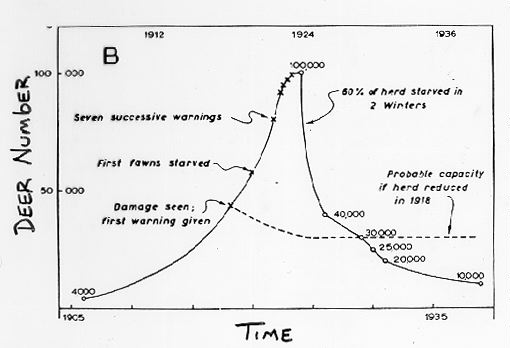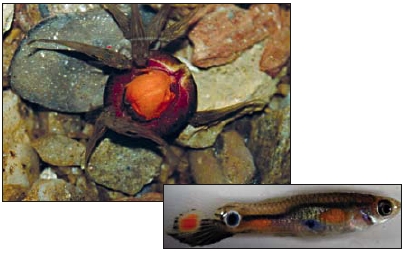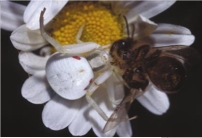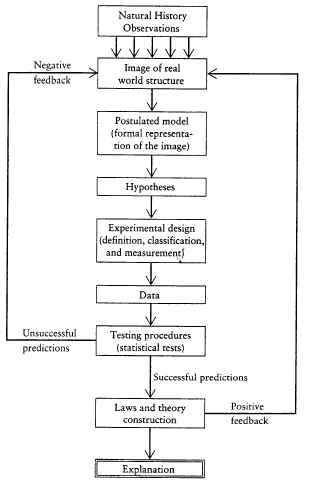Lecture notes for ZOO 4400/5400 Population Ecology
Lecture 2, 16-Jan-13 Wednesday The scientific method
Required reading: Wilson & Bossert, Chapter 1 (on WyoWeb)
Suggested reading: Fretwell, pp. x-xix (on WyoWeb)
Return to Main Index page
Go back to notes for Lecture 1, 14-Jan
Go forward to notes for Lecture 3,
18-Jan
Sometimes the best way to
learn
or
know how to do something is to know how not to do it.
Before
I introduce the scientific method, I will give an example of how
"science" can be unreliable (which is why we need skepticism,
alternative
hypotheses and experiments).
I. How not to do science
Kaibab
plateau
mule
deer crash as a cautionary example of jumping to conclusions:
Most
of
the
material for this example is taken from Caughley
(1970)
:

Figure 2.1. Illustration
of
the Kaibab plateau deer explosion and crash from Caughley's
(1970) paper.
Caughley stresses that in the first
place the original data are poor (wide disparity in different estimates
of peak populations) and that the hypothesis of "release" of limits on
the deer as a result of a predator control program eventually became a
dogma without real scrutiny of alternative hypotheses. [A
point to return to later in the course. Note the sharp peak on
the
curve -- and think about what that means in light of the required
reading by Turchin et al. (2000) on whether lemmings and voles are
predators
or prey].
Traditional explanation -- release from pressure of predation
(due to predator control program).
Alternative explanation: Grazing of 200,000 sheep on plateau declined to 5,000 between 1889 and 1908.
Sudden flush of unexploited vegetation allowed deer population to grow extremely rapidly
Grazing decrease coincided temporally with predator control. Decline in sheep grazing may have lead to vegetation release that facilitated growth of deer population.
The potential explanations -- predator control vs. change in availability of food resources are CONFOUNDED (both potential causal agents happened at the same time).
Even the information supporting the supposed pattern is questionable. It was published in several different forms, then combined in some text books on ecology and adopted as dogma. It is possible that predator control really is responsible -- that's not the main issue. The main issue is that the predator control hypothesis was accepted unreservedly, with very little consideration of alternative possibilities.
Take-home messages from Caughley (1970) :
1) Tendency for establishment of unreliable knowledge.
2) Difficulty of discriminating among alternative explanations.
What kinds of evidence could help us assess the likelihood of the two possible explanations? In this case, the best approach might be comparative. If a wide-ranging survey found abundant evidence of a change in grazing pressure or forage availability but none of release from predation, it would suggest that the change in sheep grazing was likely the more important factor.
Often, the answer is NOT an EITHER/OR but one of relative importance. Predator control may indeed have had some impact on allowing the deer to increase. But the evidence suggests that the reduction in sheep grazing was MORE important. A statistical analog would be that in a multivariate analysis of variance we seek to find the proportion of the total variance explained by a number of factors. Ideally we will be able to exclude several factors that make a minimal contribution to the variance, but often we are left with two or three that each comprise a non-negligible percentage of the total (e.g., 45% for Factor 1, 20% for Factor 2 and 15% for Factor 3). Multiple causality is a major problem in ecological hypothesis testing (Quinn and Dunham, 1983)
Comparative evidence. Irruptive patterns like the
one
shown
in Fig. 2.1 are not uncommon.
Liberation
of ungulates
St. Matthew's island in Alaska
Reindeer released (predators absent)
1944 (29)
1963 (6,000) 20 yrs
1968 (50) 5 yrs.
Moose on Isle Royale
Peaked 1920's
decline related to malnutrition
and stabilized at lower level
Indeed, Caughley found more evidence for the over-grazing than the predator control hypothesis in reviewing these and other examples of other ungulate crashes
II. What is science (and what is not)?
Skeptical, methodical evaluation of the body of evidence that seeks to establish alternative working hypotheses, and then reject some hypotheses, while retaining others (the remainder are still subject to re-evaluation in the light of new data or theory).
Science must be:
Testable (falsifiable): one should be able to think of evidence that would refute the hypothesis
Based on a body of evidence
Original/novel (desirable): novel ideas help explain previously puzzling or paradoxical phenomena
Predictive: should be able to predict that X but not Y will occur
Examples of originality/revolutions in science:
Plate tectonics in geology -- went from crank idea to worth exploring to dogma
First proposed in 1860 by Antonio Pellegrini and again in 1913 by Alfred Wegner.
Was not seriously considered until 1960’s, is now essentially "dogma"
Only plate tectonics can explain many aspects of the formation of mountain ranges, ocean subsidence, etc.
Darwin's (1859) theory of natural selection --
1) it was and is plausible
2) we have accumulated overwhelming experimental, theoretical and observational evidence is that it is accurate, interesting and important
3) arguments among serious scientists are about details of how, not whether
4) the theory has astonishing ability to explain weird phenomena that were not even known when the theory was formulated.
Here are four examples of astonishing (but predictable under natural selection) effects of natural selection:
a) Sex change operations -- the bacterial way. Only natural selection could explain the bizarre dynamics of the cytoplasmic bacterial parasite Wolbachia, which changes male hosts into functional females -- if the bacteria were in males (male cytoplasm) they would not be passed on to the next generation, since sperm do not have cytoplasm. Experimental treatment with antibiotics (which got rid of the Wolbachia) caused a change from parthenogenetic, all-female reproduction to sexual reproduction (reappearance of males) in Trichogramma wasps (small parasitoids). (We will address other amazing host-parasite interactions later in the course). Source paper: Stouthamer et al., 1990 .
b) The high price of sex . Another example of the strange power of natural selection is sexual cannibalism in an Australian Latrodectus spider (same genus as black widow). During mating, the male somersaults on to the female's fangs. More than two thirds of all copulating males are consumed by their female mates. Why? Natural selection has favored the "donation" of his body by the male -- it will increase his mate's fecundity (and thereby his evolutionary fitness). The benefit to his offspring outweighs the benefit of surviving, because a male's chances of finding another mate are negligible. The benefit is to the male, NOT "for the good of the species". Source paper: Forster, 1992.

Photo: Male redback spiders (related to our black widow spiders) "donate" their bodies as food resources
for the females. Once they find a mate, their chances of finding another are nearly zero, so they increase their fitness (number of offspring) by improving the female's nutritional condition.
c) Evolve fast or die . Poecilia reticulata are small guppies (fish) that live in streams in Trinidad. In some streams the guppies face a fearsome predatory fish, a large cichlid. In other streams the cichlids do not occur. Where they co-occur with cichlids, the guppies have evolved to mature at smaller sizes, and males are much less colorful -- these differences are genetic/heritable. Dave Reznick and his colleagues transplanted some large, colorful guppies to a cichlid-infested (but guppy-free) stream system. Within 18 guppy generations (11 years) the guppies had evolved the small maturation and reduced coloration of their relatives that had evolved over a long period in the presence of the predator. Strong selection had driven very rapid evolutionary change! Similar very rapid evolutionary change has been demonstrated for the body proportions of lizards on Caribbean islands, and for the spawning habits of Pacific salmon. The brightly-colored guppies are orange. Another researcher, Anne Houde found that the orange spots on the male guppies evolved in response to the the attraction of females to fruit (food source) that have similar coloration. Source papers: Reznick et al. 1990, Houde and Endler, 1990.

Photo: Male guppies in predator-free streams (lower right) have bright orange spots that look like the fruits to which females are attracted as food resources (photo in upper left). In the presence of predators, natural selection quickly (11 generations) reduces the brightness of the males, making them less conspicuous to the predators.
d) What color is that spider? A crab spider that catches insects on flowers needs to be cryptic to both its prey and to its predators -- the problem is that the insect prey and the bird predators have very different visual systems (both see UV that we don't but different parts of the UV and the rest of the color spectrum). It turns out that natural selection has shaped the spiders so that they are the best possible compromise. They don't do either thing perfectly, but given an imperfect set of choices, they make the best compromise. If the spiders were "intelligently designed" they would likely be a perfect match. The fact that they are a good compromise suggests that natural selection is the best (most plausible) explanation for their adaptation. Source paper: Théry and J. Casas, 2002.

Photo: the color of the cryptic crab spider (lower left) is driven by a compromise between hiding from the different visual systems of its insect prey and its avian predators.
These are examples of predictive power so great that our only problem was being acute
enough to make the prediction or observe the phenomenon. At least two of these (the guppies and the crab spiders)
have very interesting follow-up studies that modify the conclusions of the original studies. (Skeptical, testable hypotheses).
Here is the last paragraph of Charles Darwin's 1859 "On the Origin of Species by Means of Natural Selection,
or the Preservation of Favoured Races in the Struggle for Life".
"It is interesting to contemplate a tangled bank, clothed with many plants of many kinds, with birds singing on the bushes,
with various insects flitting about, and with worms crawling through the damp earth, and to reflect that these elaborately constructed forms,
so different from each other, and dependent on each other in so complex a manner, have all been produced by laws acting around us. These laws,
taken in the largest sense, being Growth with Reproduction; inheritance which is almost implied by reproduction; Variability from the
indirect and direct action of the external conditions of life, and from use and disuse; a Ratio of Increase so high as to lead to a Struggle for Life,
and as a consequence to Natural Selection, entailing Divergence of Character and the Extinction of less-improved forms. Thus, from the war of nature,
from famine and death, the most exalted object which we are capable of conceiving, namely, the production of the higher animals, directly follows.
There is grandeur in this view of life, with its several powers, having been originally breathed into a few forms or into one; and that,
whilst this planet has gone cycling on according to the fixed law of gravity, from so simple a beginning endless forms most beautiful
and most wonderful have been, and are being, evolved."
THE SCIENTIFIC METHOD
Steps in the scientific method
1)
Observation
(the emperor has no clothes; it is often a major challenge to really see
what is happening)
2) Formulate multiple working hypotheses based on the observation(s)
(example: you observe deer stotting as reaction to predator. Why? Unprofitable prey? Warning to kin? Maladaptive fear response?)
Ways of using logic to formulate hypotheses:
Induction: [From the particular to the general] Compile individual observations, facts, or measurements to arrive at a generalization. Observe that ducks have webbed feet, geese have webbed feet, seals have webbed feet - therefore animals that live in water have webbed feet - inference.
Deduction: [From the general to the particular] Movement of thought from general to specific. Animals that live in water often have webbed feet so deduce that frogs that live in water….
Retroduction: Observe phenomena, then formulate a hypothesis such that if it were true it would account for the facts
(e.g., hypothesize that predator control explains Kaibab deer crash). Retroduction is essentially how circumstantial evidence works in a court of law. It is also one of the weakest (but most widely used) ways of making inferences. [See criticism of this approach to wildlife management by Romesburg in the suggested readings].
3) Develop conceptual or mathematical models based on the alternative hypotheses
4) Devise tests of predictions generated in Steps 2 and 3
Hypotheses have consequences: "If Hyp A is true then F should happen, whereas if Hyp B is true then G should happen"
a) Consider as many as possible of the logical implications of your reasoning (if a
then b; whereas current theory/dogma predicts c)
for each alternative, search for counter-evidence or falsifiable predictions
b) discriminate among (reject) plausible alternatives with experiments
use modeling or mathematical approaches to expose and test assumptions
c) use comparative approaches -- for example, do the patterns of interest hold only in related species, only
in warm-blooded species, only in fossorial (burrowing) species?
d) When we are comparing several alternative models of how nature might operate, we can assess which best fits the
data by using methods such as the Akaike Information Criterion (AIC; see Anderson et al. 2000).
5) Evaluate results of tests (e.g., with likelihood tests, significance tests).
If results refute the working hypothesis, go back to Steps 2 and 3 and reformulate the hypotheses or
models. If the results support the working hypothesis, go back to Steps 2 and 3 and look for other predictions, corollaries, etc.
Ask new questions raised by the results.
6) Interpretation -- discuss what your results mean, the larger context,
further questions raised by your results,
weaknesses of your approach and possible alternative explanations of your results,
need for further research.
7) Pass on the knowledge gained
a) Publish in a peer-reviewed journal
(research is most useful when published and subject to critical scrutiny)
b) Train others (as an
educator, manager, or research scientist, training is an obligation)
Below is a diagram of another way to view the scientific method.
Note: As will sometimes be the case,
I will not/did not cover some of the material in these notes during my
lecture. I nevertheless consider it suitable material for testing.

Fig. 2.2. Flow chart of steps in the scientific method. (This is Fig. 1.3 from Krebs,
1994 ). Notice that both positive and negative results lead to
feedback that can change our "image of real world structure" (how we perceive nature's organization).
References:
Anderson, D.R., K.P. Burnham, and W.I. Thompson. 2000.
Null hypothesis testing problems, prevalence, and an alternative. J. Wildl. Management 64: 912-923.
Caughley, G. 1970 Eruption of ungulate populations with emphasis on Himalayan
Thar in New Zealand. Ecology 51:53-72.
Darwin, C. 1859. On the Origin of Species by Means of Natural Selection,
or the Preservation of Favoured Races in the Struggle for Life. (1962 edition by Collier Books, New York).
[ The entire text of the Origin is available online at:
ftp://metalab.unc.edu/pub/docs/books/gutenberg/etext99/
then scroll to otoos610.txt for a 1256 KB download ]
Forster, L.M. 1992. The stereotyped behaviour of sexual cannibalism in Latrodectus
hasselti (Araneae, Theridiidae), the Australian redback spider. Austr. J. Zool. 40: 1-11
Houde, A.E., and J.A. Endler. 1990. Correlated evolution of female mating preferences and male color pattern
in the guppy Poecilia reticulata. Science 248: 1405-1408.
Krebs, C.J. 1994. Ecology: The Experimental Analysis of Distribution and Abundance,
4th edn. Addison-Wesley, NY
Quinn, J.F., and A.E. Dunham. 1983. On hypothesis testing in ecology and
evolution. American Naturalist 122:602-617.
Reznick, D.N., H. Bryga, and J.A. Endler. 1990. Experimentally induced life-history
evolution in a natural population. Nature 346: 357-359.
Stouthamer, R., R.F. Luck, and W.D. Hamilton. 1990. Antibiotics cause
parthenogenetic Trichogramma (Hymenoptera/Trichogrammidae) to revert to sex. Proc. Natl. Acad. Sci.
USA 87: 2424-2427.
Théry, M., and J. Casas. 2002. Predator and prey views of spider camouflage. Nature 415: 133.
Turchin, P., L. Oksannen, P. Ekerholm, T. Oksannen, and H. Henttonen. 2000. Are lemmings prey or predators?
Nature 405: 562-565.
[A required reading later in the course].
§§§§
§§§§§§§§§§§§§§§
§§§§§§§§§§§§§§§§§
§§§§§§§§§§§§§§§§
§§
§§§§§§§§§§§§§§§
§§§§§§§§§§
Return to top of page
Go forward to notes for Lecture 3, 18-Jan




